This blog is a preview of our State of Web3 Report. Sign up here to download your copy!
Nearly all cryptocurrency tokens fall into one of two categories: Layer 1s and Layer 2s. Layer 1s are tokens with their own blockchains, while Layer 2s are built on top of Layer 1 blockchains, usually through smart contract technology. Layer 2s can be new tokens, or more complex projects known as decentralized apps, or dApps. However, there are also Layer 2 projects that don’t utilize smart contracts, such as Bitcoin’s Lightning Network, which is designed to facilitate faster and cheaper Bitcoin payments through transaction batching.
Different Layer 1 blockchains are designed and optimized for different goals. Bitcoin is designed to be a currency for simple, trustless transactions with enforced scarcity to preserve its value. However, its relatively simple structure limits what can be built on top of it. Ethereum was the first mainstream blockchain to incorporate smart contracts, and it hosted the first wave of dApps and tokens that ushered in DeFi and web3.
But, while Ethereum has become the most prominent blockchain for Layer 2 project development, its Proof of Work (PoW) mining system and high gas fees have proven an impediment to transaction speed and scalability within its DeFi ecosystem. Many, if not most, of the smart contract-enabled Layer 1 blockchains developed since were created to address those problems. Solana and Algorand, for instance, leverage a Proof of History (PoH) and Proof of Stake (PoS) consensus mechanism respectively, as well as other blockchain construction tactics, to provide lower fees and faster transaction times. Other Layer 1 blockchains, such as Avalanche, are built more for interoperability with other chains. We’ll explore each Layer 1 chain’s unique goals and characteristics in more detail later in the section.
Top 10 Layer 1 blockchains by market capitalization:
| Cryptocurrency | Market cap |
| Bitcoin | $393,497,676,980 |
| Ethereum | $132,766,970,641 |
| BNB | $34,799,746,758 |
| Cardano | $16,321,354,418 |
| Solana | $10,588,361,889 |
| Polkadot | $7,235,046,584 |
| TRON | $5,569,289,291 |
| Avalanche | $4,555,065,322 |
| Algorand | $2,098,589,432 |
| Cosmos | $1,841,840,400 |
Comparing Layer 1s: Bitcoin vs. Ethereum vs. Algorand
Using blockchain analysis, we can compare three prominent Layer 1 blockchains — Bitcoin, Ethereum, and Algorand — to see how their usage trends differ.
First, let’s ask a basic question: Which blockchain has the most active users? We approximate this below by comparing the number of unique wallets sending each currency to services over time.
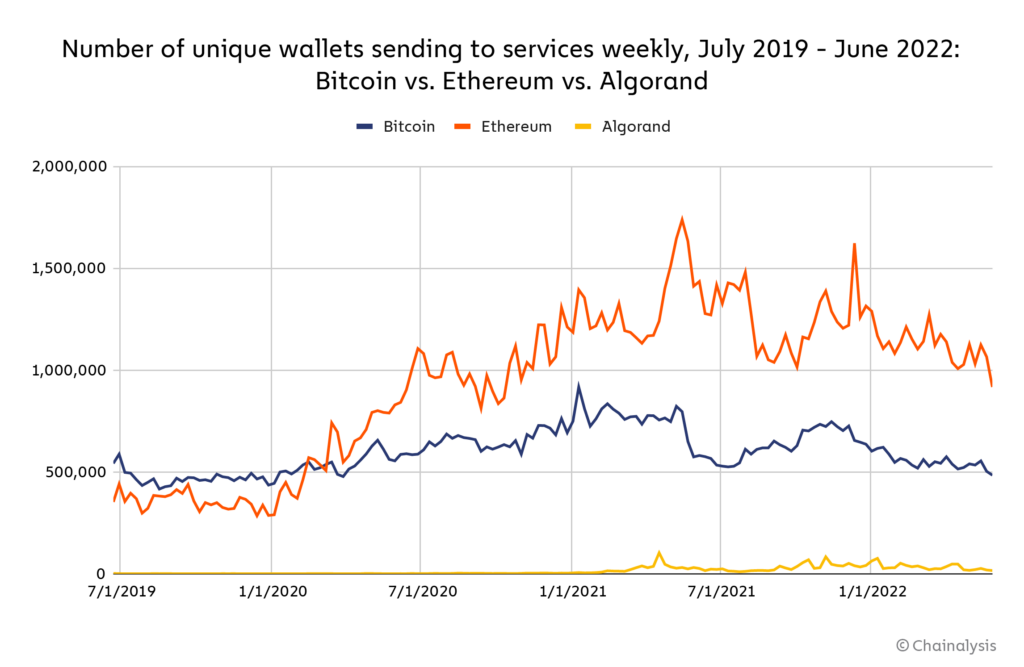
Bitcoin appears to have led in unique users until March 2020, at which point it was overtaken by Ethereum. This coincides roughly with DeFi growth, which makes sense, as the rise of DeFi fostered the creation of many services that accept Ethereum and other tokens built on its blockchain. Algorand, on the other hand, has yet to achieve comparable adoption, with a one-week high in active wallets of 103,000, compared to 1.7 million for Ethereum and 916,000 for Bitcoin.
As we can see above though, all three cryptocurrencies saw sometimes coinciding swings in active wallets throughout 2021 and 2022 to date. Overall though, each blockchain’s growth in transaction volume wasn’t correlated with the others for the most part.
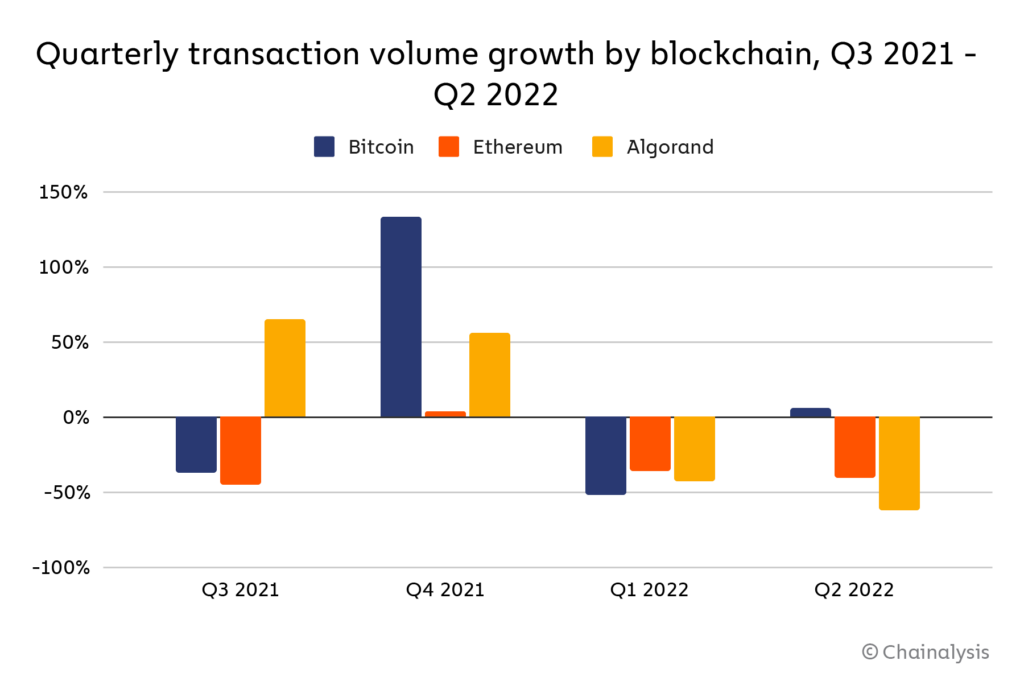
Here, we see that during Q3 2021, Algorand saw its transaction volume grow 65%, while Bitcoin and Ethereum saw volumes drop 37% and 45% respectively. This may have reflected Algorand’s growing hype — having launched in April 2019, Algorand was a relatively new blockchain, and reached an all-time price high in September 2021. Algorand and Bitcoin both grew transaction volumes significantly in Q4, during which time cryptocurrencies across the board were in a bull market, but curiously, Ethereum transaction volume grew very little. All three coins lost significant transaction volume in Q1 2022, but only Bitcoin grew in Q2, which saw steep declines possibly portending another crypto winter. That may reflect Bitcoin’s perceived status as a relatively safe coin compared to Algorand, given that the latter is a relatively new asset.
Investor profiles
We can approximate the types of investors who tend to use each of the three coins based on transaction sizes. We categorize transactions the following way:
- Small retail (<$1K)
- Large retail ($1K-$10K)
- Professional ($10K-$1M)
- Institutional ($1M-$10M)
- Large institutional (>$10M)
Below, we can see the share of total transaction volume by transaction size for the three currencies.
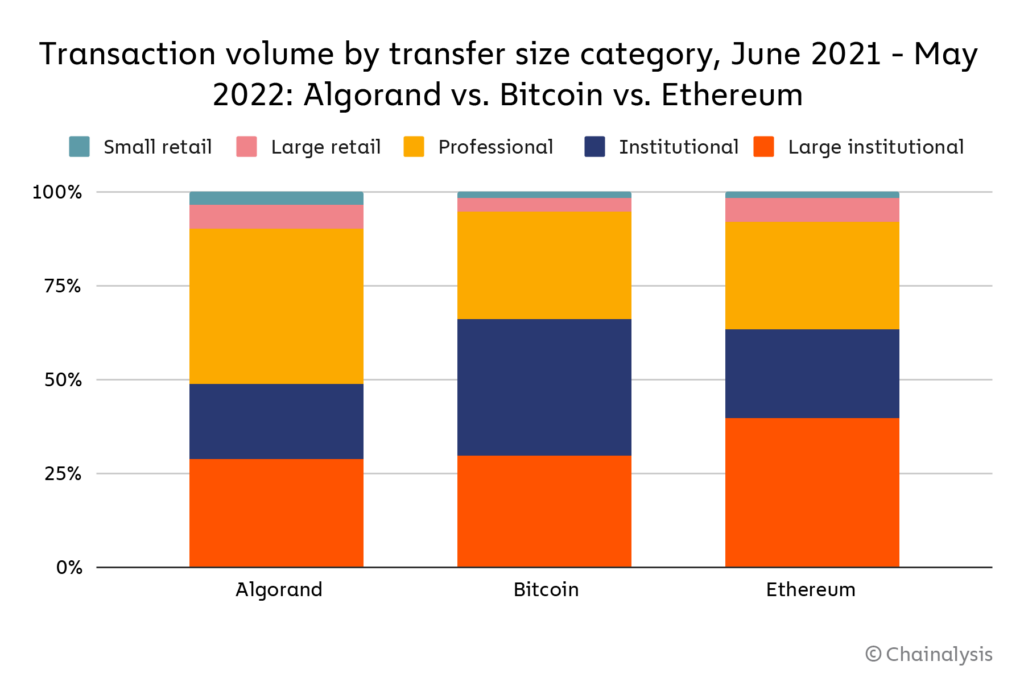
Ethereum stands out as the cryptocurrency with the most institutional dominance. 40% of its total transaction volume comes from large institutional transactions, compared to just 30% for Bitcoin and 29% for Algorand. However, if we group institutional sized transactions in with large institutional, that figure becomes 63% for Ethereum and 66% for Bitcoin — Algorand, on the other hand, sees just 49% of transaction volume made up of institutional and large institutional transactions. On the other end of the spectrum, 10% of Algorand’s transaction volume comes from retail or large retail transactions, compared to 5% for Bitcoin and 8% for Ethereum. Again, this likely reflects Algorand’s status as a relatively new blockchain. It may also signify that Algorand is succeeding in its goal of enabling a high volume of smaller transactions.
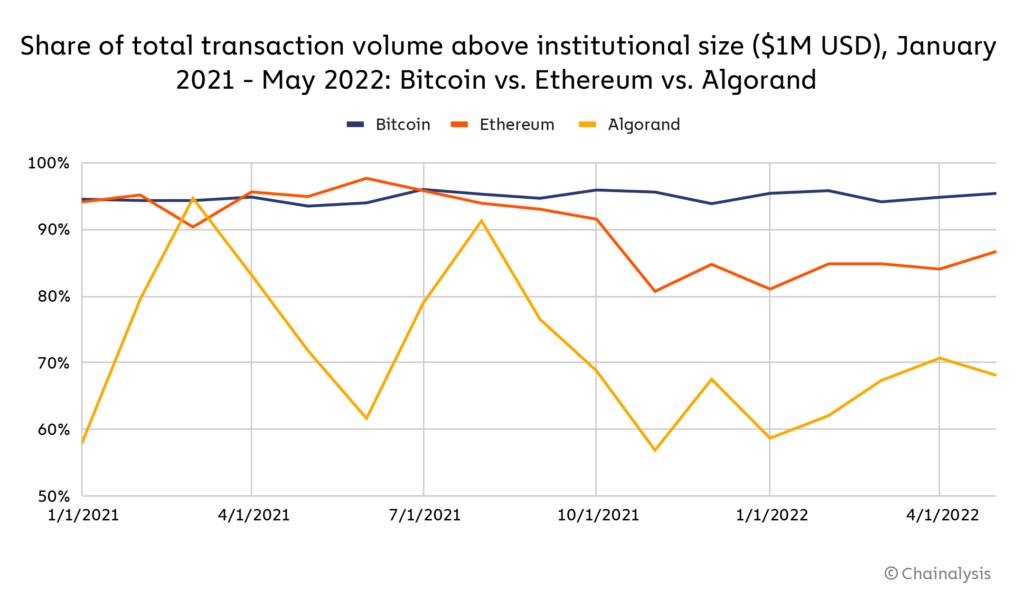
Overall, the level of institutional interest in Bitcoin stays stable, but not so for Ethereum and Algorand. Ethereum saw a slight dip in institutional interest beginning in November 2021, which has yet to recover. Algorand, on the other hand, saw a much larger dip beginning in September, which has only seen a modest recovery. Still, the rise of DeFi 2021 appears to have sparked a huge increase in investor sentiment for Ethereum relative to Bitcoin.
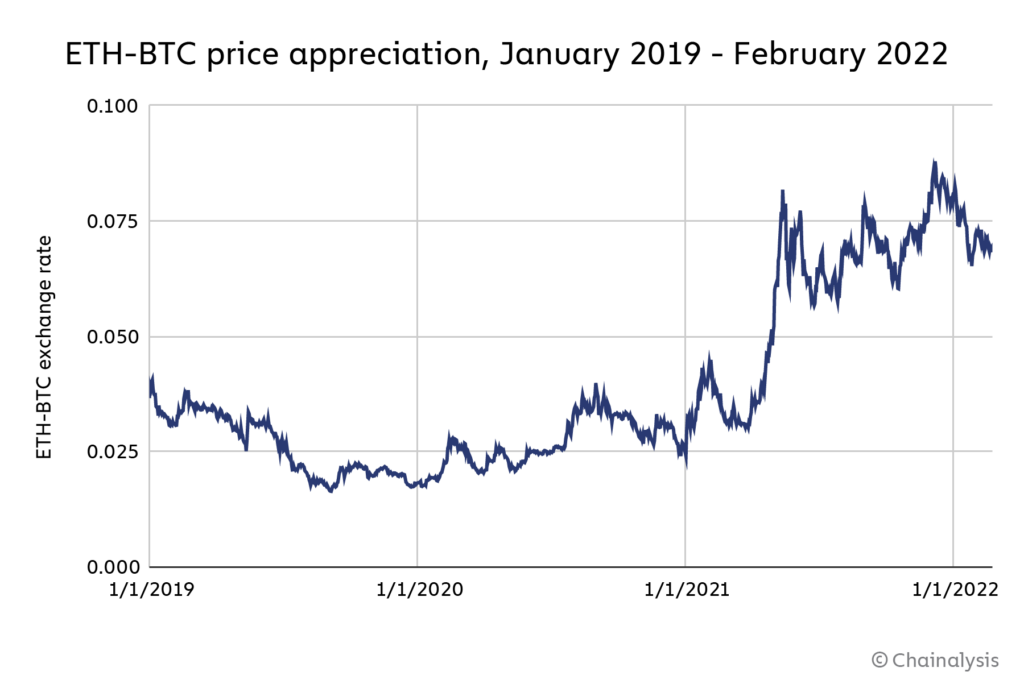
Ethereum’s price appreciation versus Bitcoin more than doubled over the course of the year, as total transaction volume skyrocketed to $4 trillion, compared to just $454 billion in 2020. That speaks to the power of web3: Smart contract functionality has created new use cases for Ethereum, leading to drastic increases in usage, and investors have taken notice.
The problem with Ethereum
Ethereum, however, isn’t perfect despite these successes. Due to its PoW consensus mechanism and current methodology for processing transactions, Ethereum can only handle roughly 15 transactions per second, compared to 1500 for non-cryptocurrency solutions such as the Visa network. Gas fees, which act as another source of compensation for miners and as a mechanism for preventing an overload of transactions, also harm Ethereum’s scalability. This is especially true for smaller transactions.
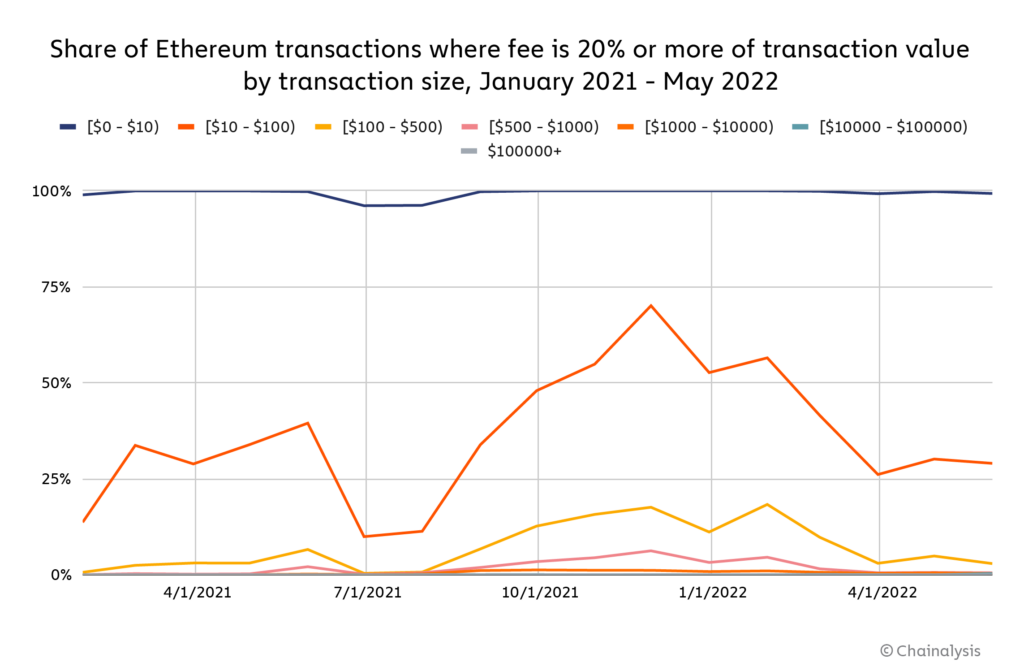
Gas fees are virtually always at least 20% or more of the actual transaction amount at values below $10, and frequently cross that threshold as well for transactions between $10 and $100. It isn’t until transactions above $500 that Ethereum fees reach parity with the average credit card transaction, which typically carries a fee of 4% or lower. DEX and NFT users bear the brunt of these fees.
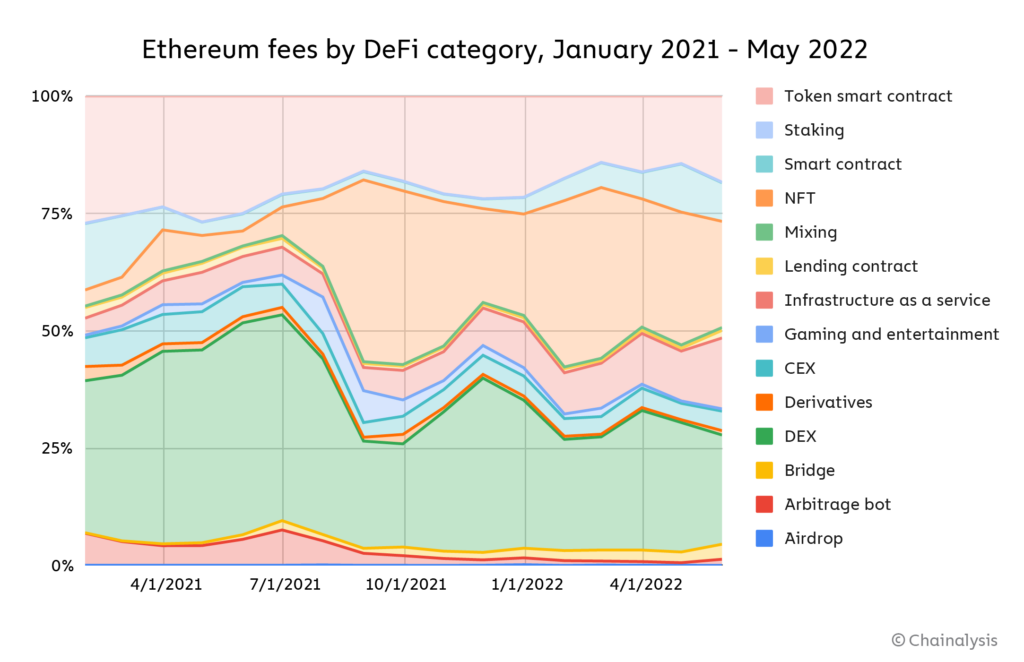
Not only that, but gas fees vary greatly hour-to-hour depending on how many people are transacting. In August 2021, Ethereum implemented a proposal called EIP-1559, also known as the London Hard Fork, that aimed to make gas fees more predictable. However, it doesn’t appear to have been successful. The grid below shows average gas fees as a percentage of transaction totals by hour and day of week for the six months prior to the London Hard Fork.
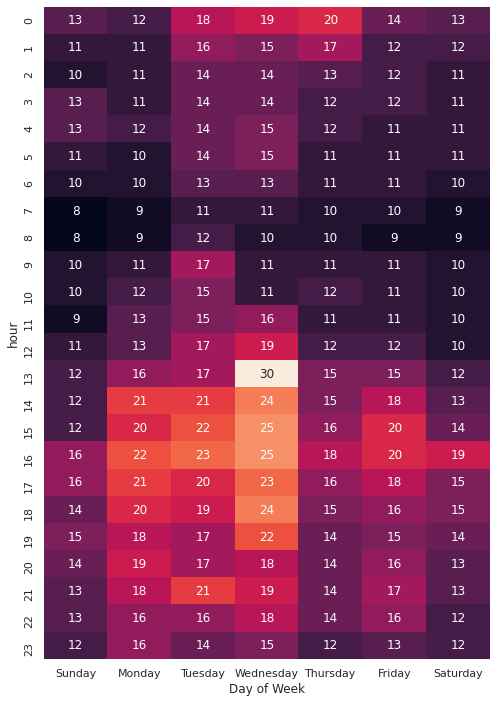
Here’s that same grid for the six months following the fork.
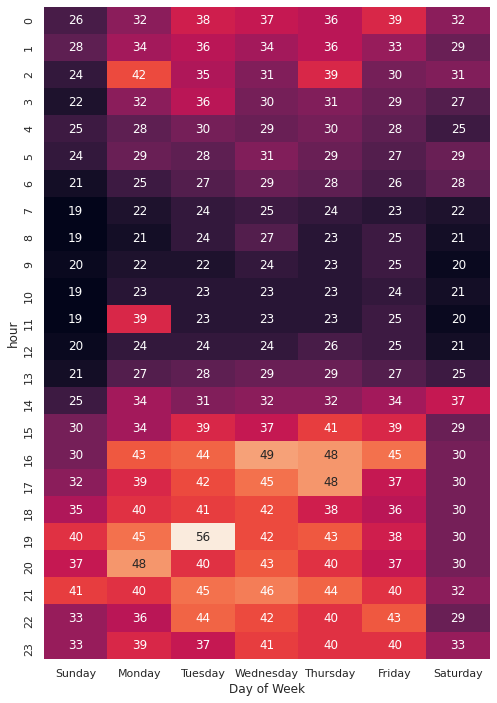
We see no meaningful difference in predictability, and in fact fees appear to have gotten higher overall since the implementation of EIP-1559, though it’s possible that EIP-1559 or a variation of it eventually ends up mitigating the issue. For now though, high gas fees, and the negative effects they have on dApp scalability, are the primary reason many developers see opportunities in creating new smart contract-enabled blockchains. We’ll look at a few of them below.
Layer 1 blockchain breakdowns: How other blockchains are building scalable solutions for web3
Solana
Solana was developed by computer scientist Anatoly Yakovenko and entrepreneur Raj Gokal starting in 2017, with the goal of addressing Ethereum’s scalability problems. Solana does this with a unique consensus mechanism that combines PoS with Proof of History (PoH). PoH seeks to solve the issue of timestamping transactions that occur on a blockchain, which determines the order in which validators confirm those transactions. While other blockchains rely on outside infrastructure for time stamping, Solana’s PoH mechanism allows timestamping to be built into the blockchain itself, which enables faster block validation and therefore faster transaction time.
Solana Foundation Communications Rep Chris Kraeuter told us that PoH enables Solana to achieve the following metrics:
- Transactions per second generally between 1,500 and 3,500, with a maximum of 65,000 depending on transaction complexity
- 400 millisecond block confirmation time
- $0.00025 in fees per transaction
These attributes have enabled Solana to become one of the biggest blockchains by total value locked (TVL) at $2.81 billion as of June 2022. While that figure fluctuates with market prices, Solana’s TVL has continuously trended upwards when measured in its native currency, and sits at 99.7 million SOL as of June 2022. That steady growth suggests that participation in the Solana ecosystem is growing consistently regardless of price swings. In fact, Kraeuter shared that Solana’s daily active users have grown more than 40% over the last 90 days.
One area where Solana is growing rapidly is NFTs. Solana still trails Ethereum in overall NFT trade volume, though it has surpassed it in individual 24-hour periods. However, Solana’s low-fee structure has made it much easier for creators to launch new projects. Nearly 15 million NFTs have been minted through Metaplex, the NFT standard on Solana, versus just over 1 million on Ethereum. It remains to be seen if the ease with which new NFTs can be created on Solana at such low costs will allow it to supplant Ethereum as the blockchain of choice for NFTs, given that the latter has a first mover advantage and more transaction volume.
Algorand
Launched in April 2019 by MIT Computer Scientist Silvio Micali, Algorand is intended to support high-frequency, payment-sized transactions. Currently, Algorand facilitates an estimated 1,000 transactions per second with five seconds for final confirmation on the blockchain. It achieves this in part with a unique, two-tiered blockchain structure. The base layer supports basic transactions, as well as smart contracts for new tokens and atomic swaps. The second layer, on the other hand, is reserved for more complex smart contracts, such as those powering dApps. This bifurcation of the Algorand blockchain enables Algorand to process transactions efficiently.
For its consensus mechanism, Algorand uses a variant of PoS called Pure Proof of Stake (PPoS), with much lower staking requirements than other PoS blockchains — 1 ALGO is all it takes to stake. This results in a more democratized blockchain, but the lower barrier to entry may disincentivize validators from acting in the best interest of the entire network at all times. However, with gas fees running high on Ethereum, many developers have chosen to build dApps on Algorand. We break down the biggest of those dApps by transaction volume below.
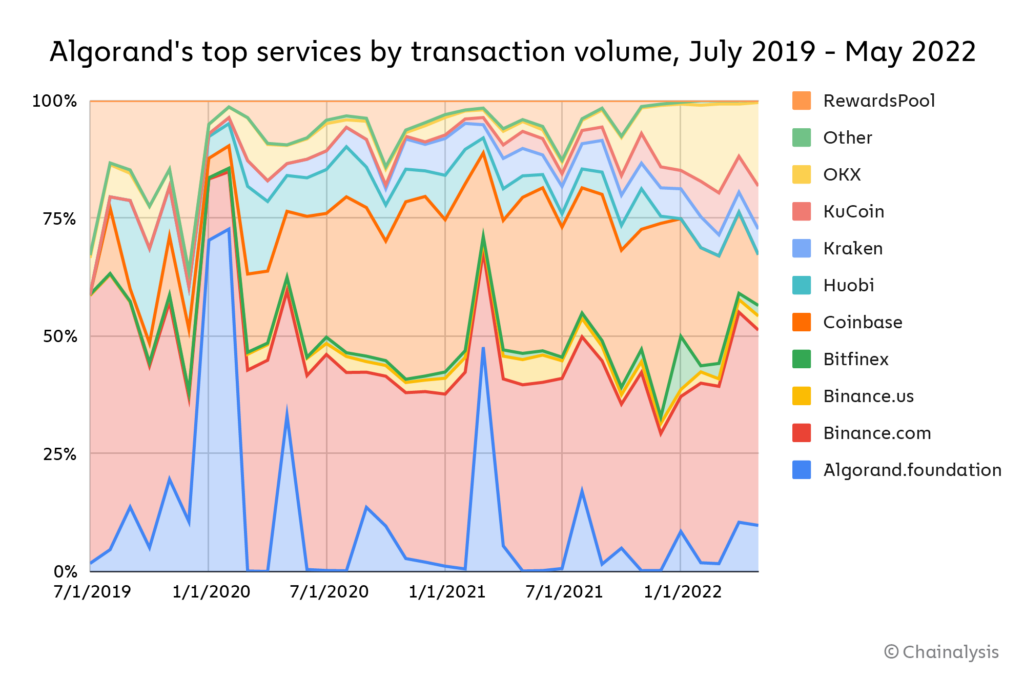
Most transaction volume for Algorand is moving through big, centralized exchanges, but its staking rewards pool also sees significant activity.
BNB Chain
Originally known as Binance Smart Chain, BNB Chain is a blockchain launched by cryptocurrency exchange Binance, with BNB being its native token. BNB chain achieved high growth for a few reasons, a key one being its capability of supporting new tokens and dApps without the high fees of Ethereum. In fact, according to DappRadar, more Layer 2 projects have been built on BNB Chain than on any other blockchain.
BNB Chain is of course also able to draw on the enormous customer base of Binance, the largest cryptocurrency exchange in the world, capitalizing on resources like Binance’s extensive language support to attract users around the globe. However, there are potential downsides to that as well. BNB Chain can’t be said to be fully trustless – in the technical sense – as it’s maintained by a centralized, legally incorporated business entity. We see one example of this in BNB Chain’s tokenomics.
As we mentioned above, there’s more being built on BNB Chain than anywhere else. But what exactly is being built? According to DappRadar, DeFi protocols make up a much bigger share of BNB Chain’s Layer 2 protocols compared to similar blockchains like Ethereum. Meanwhile, platforms devoted to NFTs and other collectibles are much less prominent.
Avalanche
Avalanche touts itself on three key attributes:
- Customizability to build a variety of dApps and tokens.
- Scalability thanks to low fees.
- Interoperability to interact with other blockchains. For instance, Avalanche is compatible with the Ethereum Virtual Machine (EVM), meaning that dApps and tokens built on the Ethereum blockchain can be migrated to the Avalanche blockchain with minimal extra effort from developers.
With these three capabilities, Avalanche says it can be a “platform of platforms” and support significant Layer 2 development. Avalanche accomplishes this with a set of three blockchains, each serving different use cases:
- C-Chain executes transactions related to Ethereum-native dApps, and is currently the most-used of the three blockchains.
- X-Chain allows for the creation and exchange of new assets built on top of the Avalanche blockchain
- P-Chain coordinates the Avalanche blockchain’s validators and the creation of subnets.
Subnets are sets of Avalanche validators responsible for a single blockchain built on top of Avalanche. Each layer 2 blockchain on top of Avalanche has one subnet, but individual subnets can validate many blockchains. The C-chain’s compatibility with Ethereum has enabled Avalanche to integrate with several large Ethereum-based DeFi projects, including bZx and SushiSwap. Meanwhile, its PoS consensus mechanism has enabled low fees and a high throughput of 4,500 transactions per second. Unlike Ethereum, Avalanche burns all transaction fees in order to create deflationary pressure for its native AVAX token, rather than pay them out to validators, as is the case on the Ethereum blockchain.
DappRadar tracks a total of 297 dApps built on Avalanche, more than half of which are DeFi protocols, while another 8% of dApps are devoted to NFTs.
What’s next for Layer 1s?
Several new Layer 1 blockchains have emerged to stake out their own place in the growing web3 ecosystem, largely driven by a demand to address Ethereum’s problems with scalability, speed, and fees. While many of them have attracted substantial investment and user bases, questions remain.
For instance, will any of them surpass Ethereum in adoption? Many new Layer 1 blockchains perceived to solve Ethereum’s problems have been billed as “eth killers” primed to replace the second-most popular cryptocurrency as the go-to for web3 and DeFi, but so far, none have been able to do it. Ethereum is still far ahead in transaction volume, especially in popular areas of web3 like NFTs, and the Ethereum Foundation is working with miners to implement changes to address its issues. The upcoming Ethereum 2.0 upgrade, which will see Ethereum switch to a PoS consensus mechanism and implement sharding to process a higher number of transactions in parallel, is expected to increase Ethereum’s scalability. If Ethereum’s entrenched status as the number two blockchain behind Bitcoin is already allowing Ethereum to fend off competitors, it seems especially unlikely that another smart contract-enabled blockchain will challenge it should these changes prove successful.
That would raise another question: If new Layer 1 blockchains can’t challenge Ethereum, will they survive as alternatives in the long term? So far, many new Layer 1 blockchains have attracted investment at least in part by convincing investors they can challenge Ethereum in the long term, and the bull market of 2021 allowed them to attract new investors as prices grew. With a possible crypto winter on the horizon along with improvements to Ethereum, it’s possible that investment in alternative Layer 1s slows down, and that web3 becomes a winner-takes-all market, with Ethereum as the dominant player.
This blog is a preview of our State of Web3 Report. Sign up here to download your copy!
This website contains links to third-party sites that are not under the control of Chainalysis, Inc. or its affiliates (collectively “Chainalysis”). Access to such information does not imply association with, endorsement of, approval of, or recommendation by Chainalysis of the site or its operators, and Chainalysis is not responsible for the products, services, or other content hosted therein.
This material is for informational purposes only, and is not intended to provide legal, tax, financial, or investment advice. Recipients should consult their own advisors before making these types of decisions. Chainalysis has no responsibility or liability for any decision made or any other acts or omissions in connection with Recipient’s use of this material.
Chainalysis does not guarantee or warrant the accuracy, completeness, timeliness, suitability or validity of the information in this report and will not be responsible for any claim attributable to errors, omissions, or other inaccuracies of any part of such material.
